#marie sophie of bavaria
Explore tagged Tumblr posts
Text


Duchess Ludovika in Bavaria to her sister Archduchess Sophie of Austria, on the possible engagement of Archduke Karl Ludwig to Princess Maria Annunziata of Bourbon-Two Sicilies:
August 22, 1861 (...) My Marie [Queen of the Two Sicilies] wrote to me the other day that it was her husband [Francesco II]'s wish that his eldest sister [Maria Annunziata] could become your Karl [Ludwig]'s wife. Perhaps I should have expressed it in a much more fanciful way, but I didn't quite know how, so I fell through the door. I will now copy to you what Marie says of this sister-in-law: “Certainly Karl can find no better wife, and Aunt Sophie no better daughter-in-law. She is so shy and so learned, has such a noble, open character, such a lively spirit and so much resource, and at the same time such calm, gentle manners, just as I would wish for a wife for Gackel [Karl Theodor, Marie's brother] and a daughter-in-law for you; this must be proof for Aunt Sophie and Karl of how excellent the girl is. Although Petita [Princess Maria Immacolata, Annunziata's younger sister] is much prettier, everyone prefers Ciolla [Annunziata's nickname] because of her character, which is imprinted on her face, which is also pretty and has something so engaging and warm. I hope you will succeed in winning Aunt Sophie over to this idea; I would be indescribably happy, because I love the girl so much! I expect a good answer from you, with indescribable impatience”
Pictured: Princess Maria Annunziata and Archduke Karl Ludwig, by Oscar Kramer, circa 1862 (left). Queen Marie Sophie of the Two Sicilies, unknown, circa 1860 (right). Via ÖNB.
#matchmaker marie!#also this is from#sexau's pdf#queen marie sophie of the two sicilies#maria annunziata of bourbon-two sicilies archduchess of austria#archduke karl ludwig of austria#ludovika of bavaria duchess in bavaria#sophie of bavaria archduchess of austria
33 notes
·
View notes
Text
*BOOK REPORT*
Napoleon and His Son by Pierre Nezelof


First of all, this book is called a "fictionalized biography" so that leaves me to doubt most of it as "fact", at least in a word for word sense. That is my disclaimer.
This book, unlike most Napoleon books I have read, tells what the characters are thinking and feeling and saying. It seems that normally in books, direct and known quotes are the only dialogue that occurs. The way that this one is written makes it feel as if you are really there and it is easy to visualize. It's not just some dry spouting of facts. That being said, I'm not sure how historically accurate it really is.
Our story begins with Marie Louise finding out that Napoleon has divorced Josephine and is looking for a bride. She soon finds out that she is the intended target and is upset, calling Napoleon "the devil" and "the antichrist".
The story progresses through their marriage and the birth of Napoleon II. Here is the one part where I actually feel bad for Marie Louise. I can relate to her on a mom level. She had a difficult birth and then, by etiquette at the time, didn't have the moments of bonding needed for a mother and baby, especially your first baby. Napoleon II had servants for everything. He did not even need his parents. A wet nurse breastfeed him, which again, was common at the time, but breastfeeding and skin to skin contact with a baby is a HUGE thing in bonding. Marie Louise never had that chance. Now I'm not condoning her neglectful behavior later on, but I understand the reason. She did not feel close with Napoleon II, and I think that made it easier for her to just ignore him and leave him to be brought up by tutors. I know with my first son, not having EVER been around babies, that I didn't know how to connect with him at first. My husband went as far as to accuse me of not loving our son when really I just didn't know how to interact with a baby. Once I figured that out, things were much better. But what I'm saying here, is that she didn't get the chance to figure that out. She didn't have to. There were people for her son's every need except that of a real mother.
Once Napoleon went into exile, first at Elba, and then again to St. Helena, Marie Louise ran back to the only life she knew without Napoleon: Austria. Napoleon II was only a toddler. They took away his toys and French clothes and did their best to make him an Austrian prince under Metternich's careful watch. They began calling him Franz. Eventually all his French staff were removed and replaced with Austrian staff. He was kept in the dark about many things concerning his father, especially where he currently was and how he was being treated. Meanwhile, Marie Louise had quickly fallen in love with Count Neipperg, and was concealing her new life, and even new children! from her son. She was away from Franz for years at a time, often making excuses on why she couldn't travel to see him.
Franz's only friends were Sophie of Bavaria and Prokesch von Osten. Sophie was his comfort and Prokesch was his hope. They were always making grand plans to help Franz return to the French throne. He felt that these were the only people he could trust. Everyone else reported back to Metternich, who was basically holding him prisoner, keeping him away from France and even his own inheritance.
Unfortunately, Franz was a sickly young man. By the time he was 21, he was on his deathbed. Unfortunately, Prokesch was away - meeting with Franz's grandmother, Laetitia (as it is spelled in this book), mother of Napoleon Bonaparte. Sophie went into labor also at this time with her second child, and was unable to see Franz once more. She had barely left his bedside during his illness despite her pregnancy. Begrudgingly, Marie Louise showed up, ordered by her father to do so. She couldn't stomach the sight of her dying son and kept fainting/running out of the room/leaving him alone. Franz died of Tuberculosis and Metternich slept easily, knowing that the threat of Napoleon was gone.
It was a very good book with an engaging story. I would definitely recommend, but again, I caution that it might not be 100% fact.
#napoleon#napoleon bonaparte#marie louise#napoleon ii#franz#duke of reichstadt#l'aiglon#king of rome#sophie of bavaria#prokesch von osten#klemens von metternich#napoleonic#austria#book report#napoleon and his son#pierre nezelof
36 notes
·
View notes
Note
prettiest royal woman iyo?
Queen Alexandra
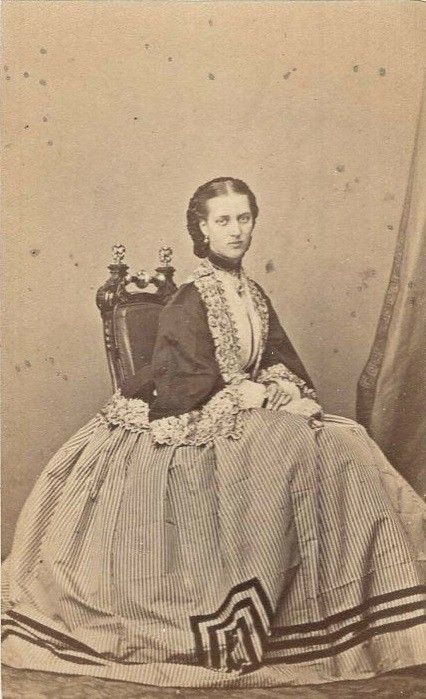
Empress Maria Feodorovna
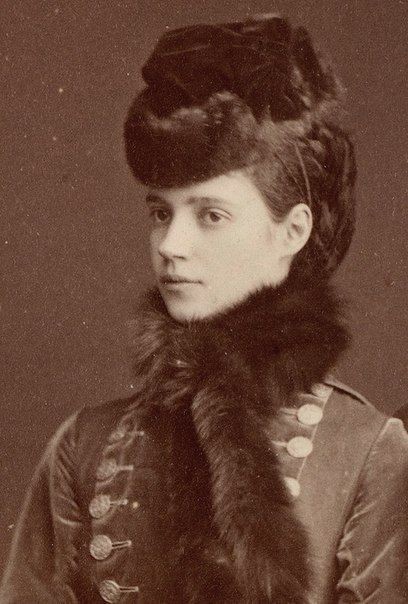
Grand Duchess Tatiana Nikolaevna
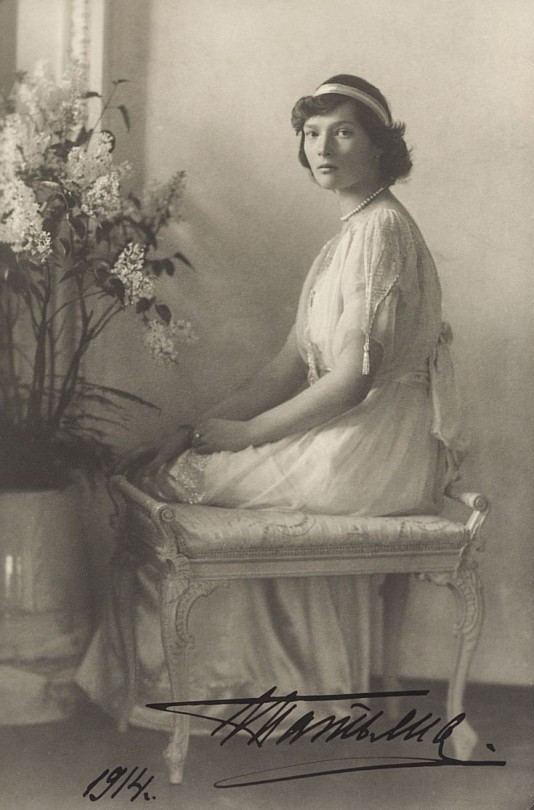
Empress Victoria of Germany
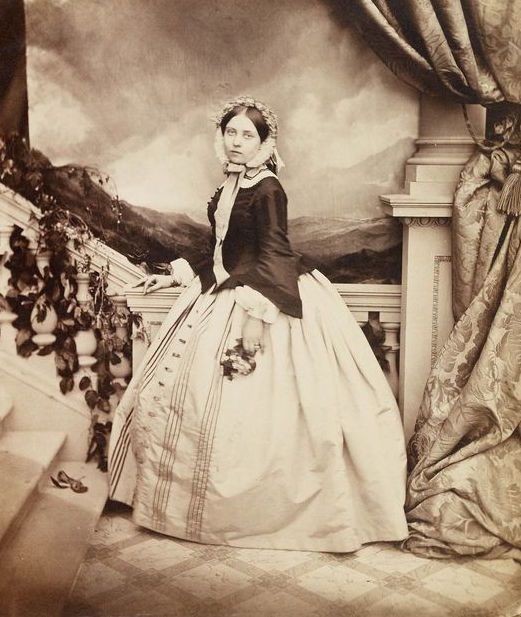
Queen Maud of Norway
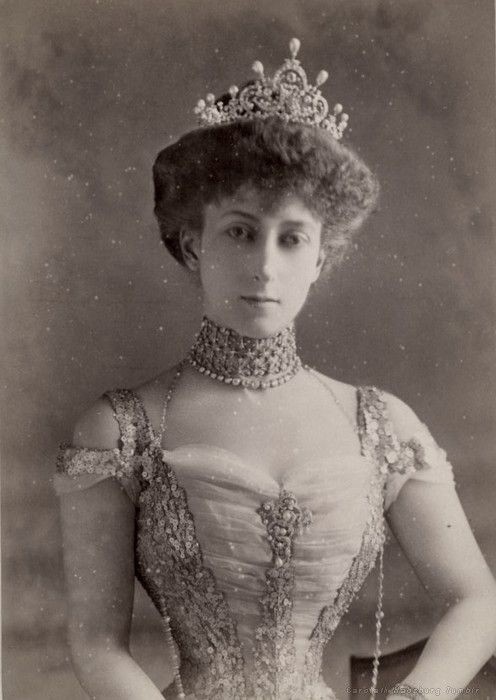
Grand Duchess Elisabeth Feodorovna
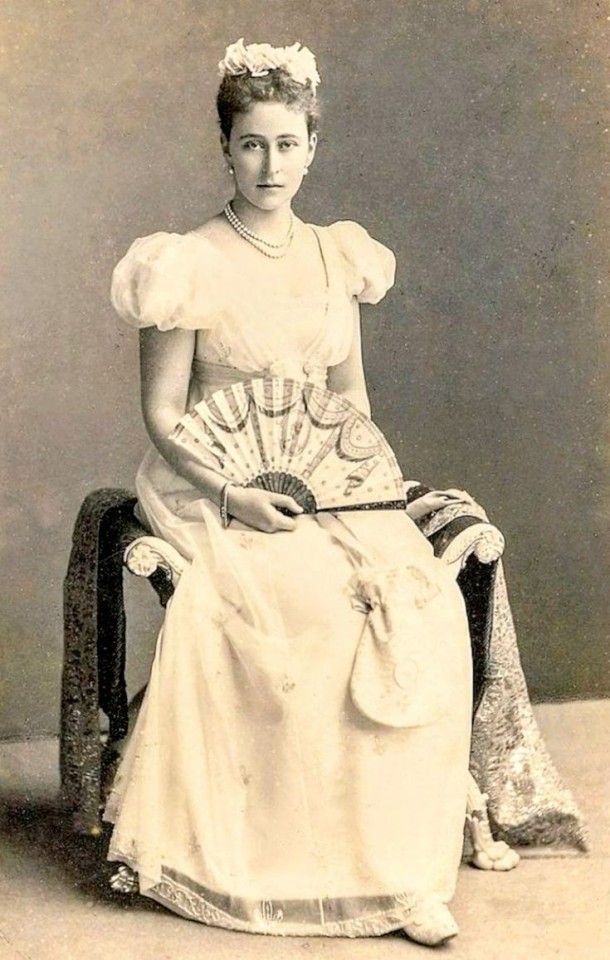
Queen Sophia of Greece
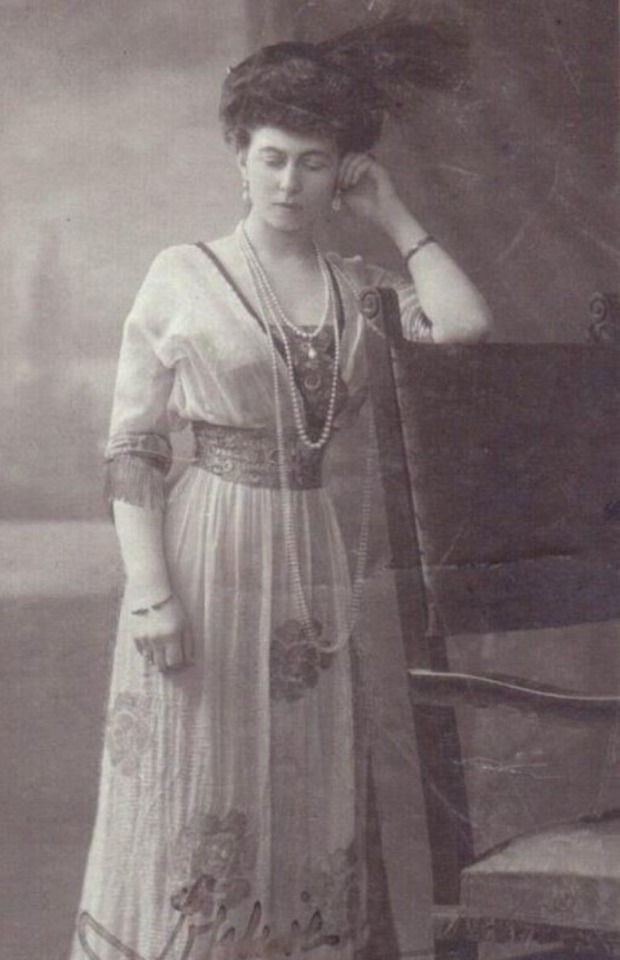
Queen Maria Sophie of the Two Siciles
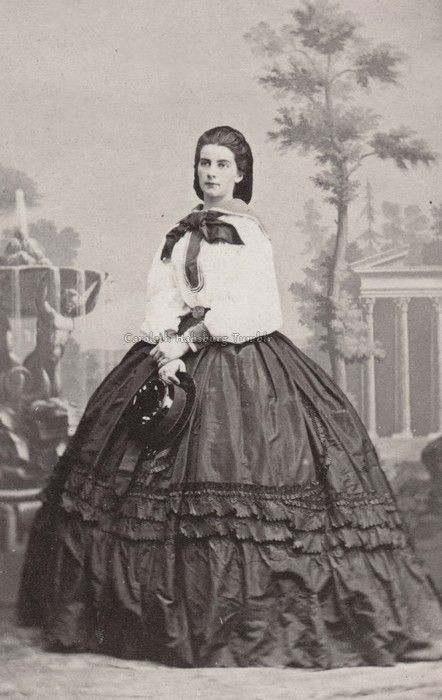
Princess Margaret
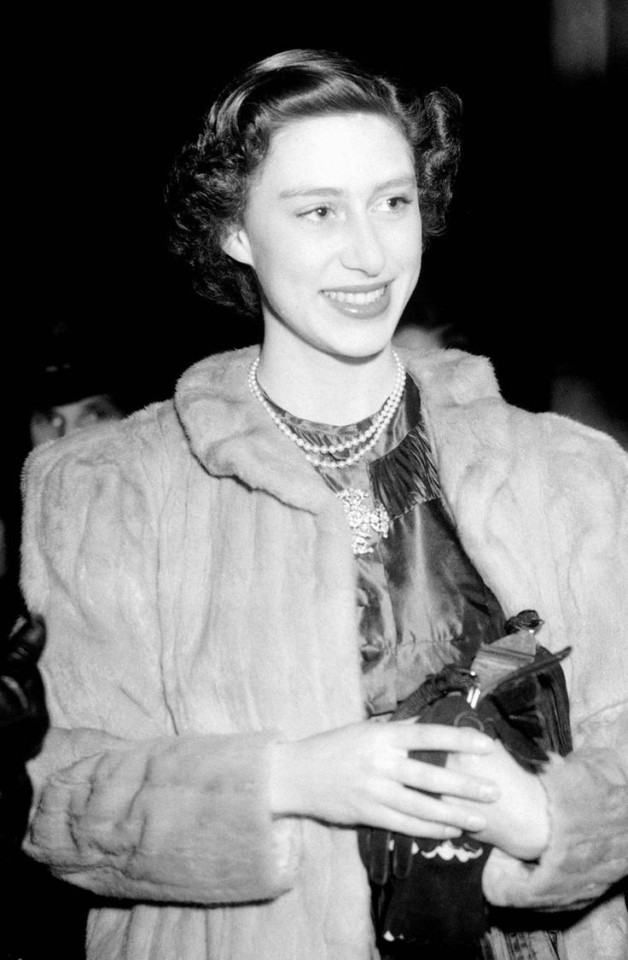
Princess Beatrice of Edinburgh, Duchess of Galliera.
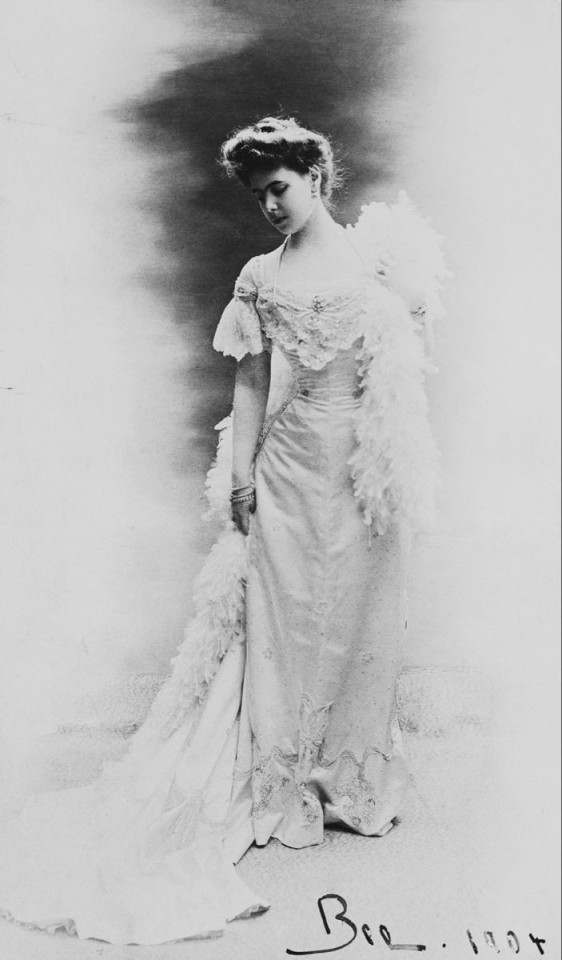
#answered ask#queen alexandra#alexandra of denmark#empress maria feodorovna#dagmar of denmark#grand duchess tatiana nikolaevna#victoria princess royal#empress victoria of germany#maud of wales#queen maud of norway#grand duchess elisabeth feodorovna#elisabeth of hesse#queen sophia of greece#princess sophia of prussia#queen marie sophie of the two sicilies#duchess marie sophie in bavaria#princess margaret#countess of snowdon#princess beatrice of edinburgh#duchess of galliera
17 notes
·
View notes
Text










Royal Birthdays for today, January 23rd:
Louis III, Elector Palatine, 1378
Marie of Prussia, Margravine of Brandenburg-Bayreuth, 1579
Violante Beatrice of Bavaria, Grand Duchess of Tuscany, 1673
Ulrika Eleonora, Queen Regnant of Sweden, 1688
Sophie Antoinette of Brunswick-Wolfenbüttel, Duchess consort of Saxe-Coburg-Saalfeld, 1724
Purachatra Jayakara, Prince of Thailand, 1881
Charlotte, Grand Duchess of Luxembourg, 1896
May of Teck, Lady Abel Smith, 1906
Caroline, Princess of Hanover, 1957
Kesang Choden Wangchuck, Princess of Bhutan, 1982
#louis iii#ulrika eleonora of sweden#marie of prussia#Sophie Antoinette of Brunswick-Wolfenbüttel#grand duchess charlotte#princess caroline#Kesang Choden Wangchuck#Violante Beatrice of Bavaria#may of teck#Purachatra Jayakara#long live the queue#royal birthdays
6 notes
·
View notes
Text
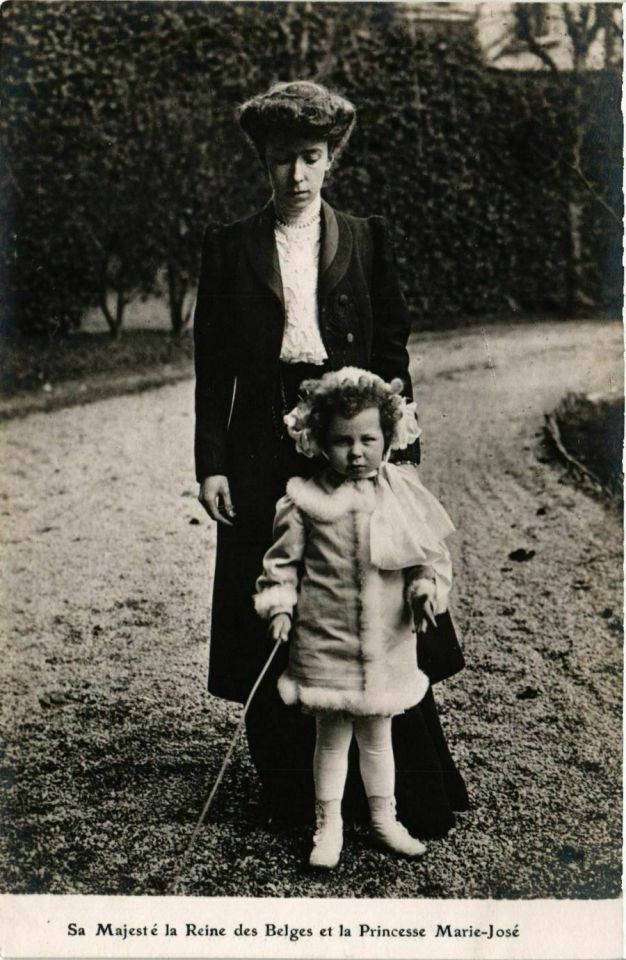
Duchess Elisabeth Gabriele Valérie Marie of Bavaria, Queen consort of the Belgians with her daughter Princess Marie-José Charlotte Sophie Amélie Henriette Gabrielle of Belgium, later Queen consort of Italy
Belgian vintage postcard
#marie-josé#queen#bavaria#marie#briefkaart#vintage#sophie#henriette#postcard#postkaart#sepia#princess#carte postale#postal#charlotte#duchess#amélie henriette gabrielle#belgium#valrie#elisabeth#photo#belgian#italy#ansichtskarte#ephemera#belgians#historic#amlie#gabriele#gabrielle
10 notes
·
View notes
Text
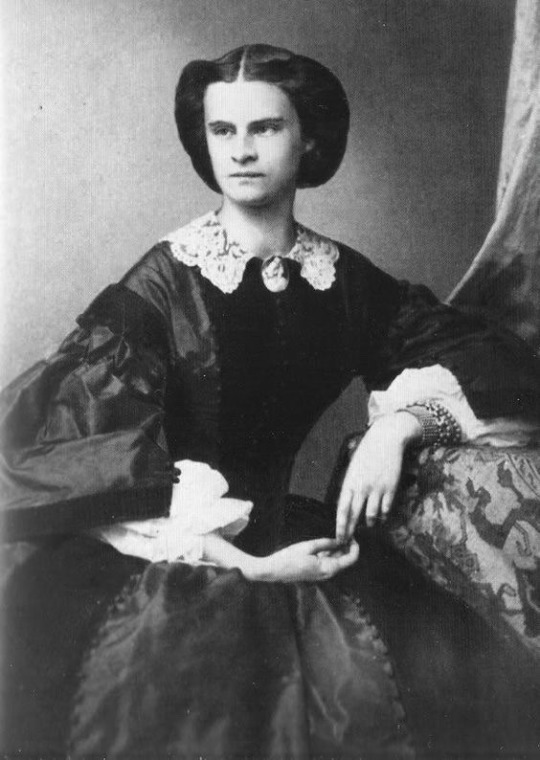
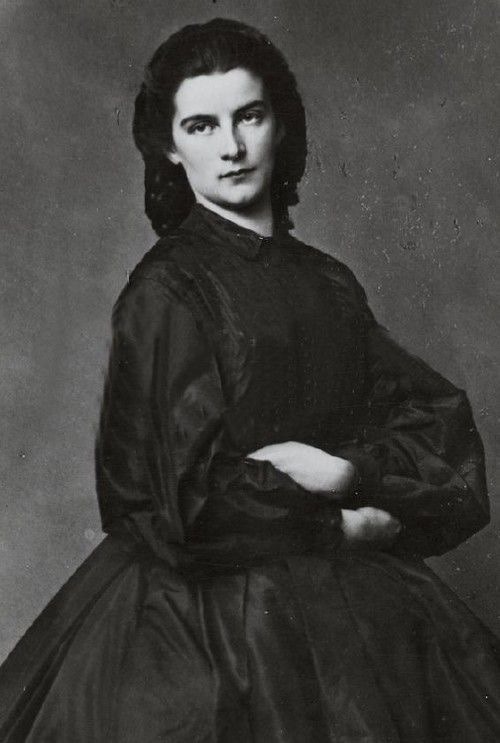
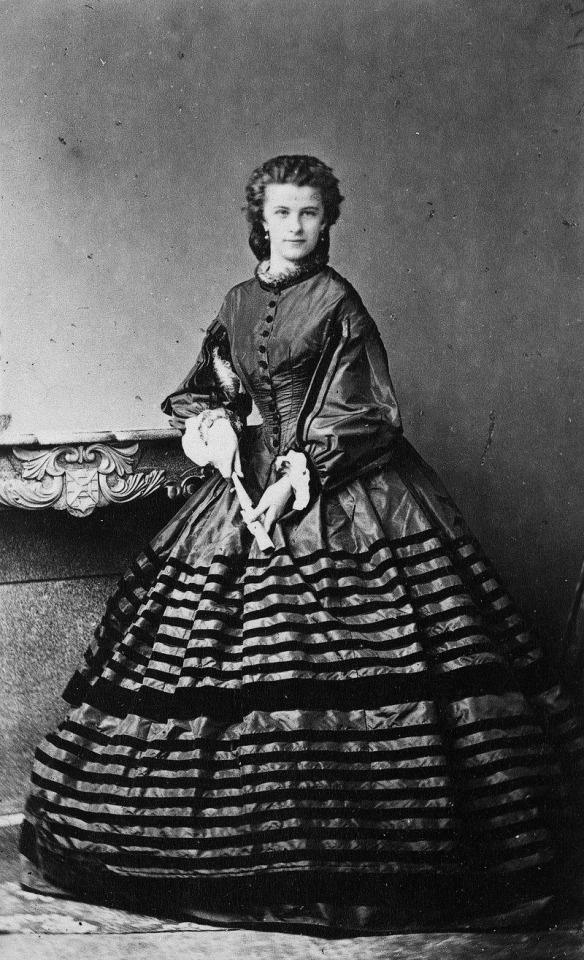
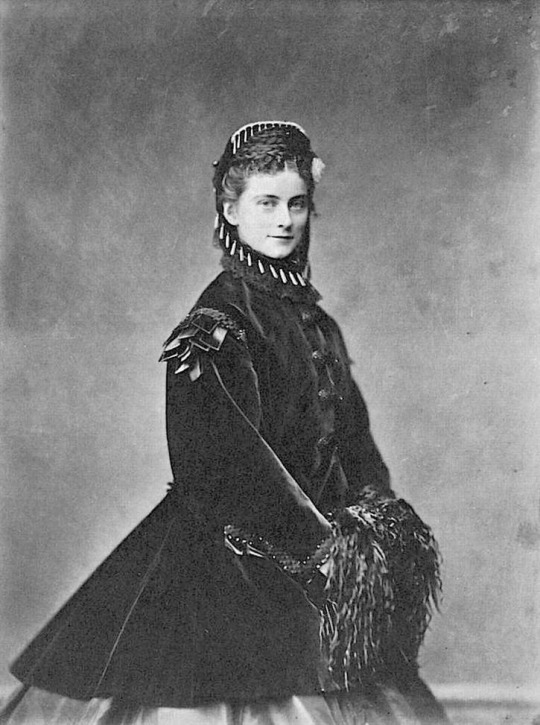
The four sisters of Elisabeth (left to right) :
Helene Caroline Therese, Duchess in Bavaria then Hereditary Princess of Thurn and Taxis. (1834-1890)
Marie Sophie Amélie, Duchess in Bavaria, Duchess of Calabre then Queen Consort of the Two-Sicilies. (1841-1925)
Mathilde Ludovika, Countess of Trani. (1843-1925)
Sophie Charlotte Auguste, Duchess in Bavaria then Duchess of Alençon. (1847-1897)
#Marie-Sophie in Bavaria#Helene in Bavaria#Mathilde in Bavaria#Sophie-Charlotte in Bavaria#old photographs#portraits#sisters#sisterhood
11 notes
·
View notes
Photo
She was a true beauty! ❤🫀

Maria Sofia Queen of Naples
66 notes
·
View notes
Text
Master Post - A to M
If you notice any show, movie or character missing that I’ve made gifs of, please let me know. Characters are sorted alphabetically by first their last name and then their first name.
Last updated: February 15th, 2025
A
Aladdin [2019] (Princess Jasmine)
Allerleirauh (Princess Friederike | Princess Lotte)
American Song Contest (2022)
Aschenputtel [2010] (Marie/Aschenputtel)
Aschenputtel [2011] (Annabella | Aschenputtel/Cinderella)
Australia [2008] (Sarah Ashley)
B
Barbie (Stereotypical Barbie)
Beauty and the Beast [2017] (Madame de Garderobe | Mrs Potts)
Becoming Elizabeth (Amy Robsart | Mary Tudor)
Blood, Sex & Royalty (Anne Boleyn | Mary Boleyn)
Bridgerton (Tilley Arnold | Lady Berbrooke | Benedict Bridgerton | Daphne Bridgerton | Eloise Bridgerton | Francesca Bridgerton | Hyacinth Bridgerton | Violet Bridgerton | Queen Charlotte | Cressida Cowper | Agatha Danbury | Penelope Featherington | Philippa Featherington | Prudence Featherington | King George III | Siena Rosso | Edwina Sharma | Kathani "Kate" Sharma | Mary Sharma | Tessa | Marina Thompson | Extras)
Britain’s Bloody Crown (Margaret of Anjou | Margaret Beaufort | Elizabeth Woodville)
C
Cinderella [2015] (Anastasia Tremaine | Drisella Tremaine | Ella)
D
Das Adlon (Sonja Schadt)
Death on the Nile [2022] (Jacqueline de Belleforte | Linnet Ridgeway-Doyle)
Die Galoschen des Glücks (Princess Aurora)
Die Kaiserin (Charlotte of Belgium | Maria Alexandrovna / Marie of Hesse | Elisabeth “Sisi” of Austria | Archduchess Sophie of Austria)
Die Salzprinzessin (Princess Amélie | Princess Eugenia | Princess Isabella)
Die Schöne und das Biest (Elsa)
Disney Live Action (see the individual movies | Extras)
Doctor Who (Ashildr | Cyril Arwell | Lily Arwell | Madge Arwell | Reg Arwell | Rosanna Calvierri | Miss Chandrakala | Agatha Christie | Hugh Curbishley | The Doctor | Twelth Doctor | Clemency Eddison | Jack Harkness | King James I | Katherine | Donna Noble | Madame de Pompadour | Amy Pond | Bill Potts | Robina Redmond | Becka Savage | Willa Twiston | Extras)
Domina (Agrippa | Antonia Major | Antonia “Antonina” Minor | Emperor Augustus | Julia the Elder | Livia Drusilla | Marcella | Octavia Minor)
Downton Abbey (Lucy Branson (née Smith) | Cora Crawley | Edith Crawley | Mary Crawley)
Dune: Prophecy (Ynez Corrino)
Dynasty [2017] (Kirby Anders | Fallon Carrington)
E
Effie Gray [2014] (Euphemia “Effie” Gray)
Elizabeth Duology (Elizabeth I)
Emerald City (Langwidere of Ev)
Emma [2020] (Isabella Knightley | Emma Woodhouse)
Eurovision Song Contest (1970 | 1974 | 1979 | 1980 | 1982 | 1988 | 1991 | 1992 | 1993 | 1995 | 1996 | 1998 | 2003 | 2004 | 2005 | 2006 | 2007 | 2008 | 2009 | 2010 | 2011 | 2012 | 2013 | 2014 | 2015 | 2016 | 2017 | 2018 | 2019 | 2021 | 2022 | 2023 | 2024)
F
Frauen, die Geschichte machten (Catherine the Great)
G
Galavant (Madalena)
Game of Thrones (Myrcella Baratheon | Cersei Lannister | Ellaria Sand | Sansa Stark | Daenerys Targaryen | Margaery Tyrell)
Good Omens (Aziraphale | Crowley)
Grey’s Anatomy (Lexie Grey | Izzie Stevens)
H
Hamilton (Angelica Schuyler | Eliza Schuyler Hamilton)
House of the Dragon (Jeyne Arryn | Alicent Hightower | Mysaria of Lys | Aegon II Targaryen | Baela Targaryen | Helaena Targaryen | Rhaena Targaryen | Rhaenyra Targaryen | Rhaenys Targaryen | Laena Velaryon)
I
J
K
Ku’damm (Helga von Boost)
L
Legacies (Jo Laughlin | Hope Mikaelson | Elizabeth “Lizzie” Saltzman | Josette “Josie” Saltzman)
Les Misérables [2018] (Cosette | Fantine Thibault)
Little Women [2019] (Amy March | Margaret “Meg” March)
Ludwig II [2012] (Elisabeth “Sisi” of Austria | Ludovika, The Duchess in Bavaria | Sophie in Bavaria)
M
Maleficent Duology (Princess Aurora | Queen Ingrith of Ulstead)
Märchenperlen (see the individual movies)
Maria Theresia [2017] (Maria Anna of Austria | Empress Maria Theresia | Mademoiselle de Chartres | Elisa Fritz)
Marie Antoinette [2006] (Jeanne du Barry | Marie Antoinette | Empress Maria Theresia | Marie Thérèse Louise of Savoy, Princesse de Lamballe | Extras)
Marie Antoinette [2022] (Marie Antoinette)
Mary Queen of Scots [2013] (Mary Stuart)
Maximilian - Das Spiel von Macht und Liebe / Maximilian and Marie de Burgogne (Maximilian of Austria | Mary of Burgundy | Bishop de Clugny | Johanna von Hallewyn | Rosina von Kraig | Georg Rudolfer | Margaret of York)
My Fair Lady (Eliza Doolittle)
My Lady Jane (Jane Grey | Mary Tudor)
Go to N-Z
19 notes
·
View notes
Text

Elisabeth of Austria
Artist: Franz Xaver Winterhalter (German, 1805–1873)
Title: Empress Elisabeth of Austria in Courtly Gala Dress with Diamond Stars
Genre: Portrait
Depicted People: Empress Elisabeth of Austria
Date: 1865
Medium: Oil on Canvas
Collection: Kunsthistorisches Museum
In Winterhalter’s 1865 portrait, Empress Elizabeth of Austria (known as Sissi) wears a white satin evening dress covered with thousands of silver foil stars shimmering under the layer of tulle. The dress, thought to be designed by Worth, follows fashionable trends of the era, but also has singular touches, like the stars, befitting her status as Empress.
Elisabeth (born Duchess Elisabeth Amalie Eugenie in Bavaria; 24 December 1837 – 10 September 1898), nicknamed Sisi or Sissi, was Empress of Austria and Queen of Hungary from her marriage to Emperor Franz Joseph I on 24 April 1854 until her assassination in 1898.
Elisabeth was born into the Ducal royal branch of the Bavarian House of Wittelsbach but enjoyed an informal upbringing before marrying her first cousin, Emperor Franz Joseph I, at 16. The marriage thrust her into the much more formal Habsburg court life, for which she was unprepared and which she found suffocating. Early in the marriage, she was at odds with her mother-in-law, who was also her maternal aunt, Archduchess Sophie, who took over the rearing of Elisabeth's daughters, one of whom, Sophie, died in infancy. The birth of a son, Crown Prince Rudolf, improved Elisabeth's standing at court, but her health suffered under the strain. As a result, she would often visit Hungary for its more relaxed environment. She came to develop a deep kinship with Hungary and helped to bring about the dual monarchy of Austria-Hungary in 1867.
The death of Elisabeth's only son and his mistress Mary Vetsera in a murder–suicide at his hunting lodge at Mayerling in 1889 was a blow from which the Empress never recovered. She withdrew from court duties and travelled widely, unaccompanied by her family. In 1890, she had the palace Achilleion built on the Greek island of Corfu. The palace featured an elaborate mythological motif and served as a refuge, which Elisabeth visited often. She was obsessively concerned with maintaining her youthful figure and beauty, developing a restrictive diet and wearing extremely tightlaced corsets to keep her waist looking very small.
While travelling in Geneva in 1898, Elisabeth was fatally stabbed in the heart by an Italian anarchist named Luigi Lucheni. Her tenure of 44 years was the longest of any Austrian empress.
#portrait#elisabeth of austria#empress elisabeth of austria#franz xaver winterhalter#fashion#courtly gala dress with diamond stars#19th century art#19th century austria#austrian royalty#austrian queen#austrian empress#landscape#queen of hungary
9 notes
·
View notes
Text
😍😍😍

Queen Marie Sophie of The Two Sicilies, born Duchess in Bavaria. A carte de visite photograph by Fratelli D'Alessandri, Rome circa 1861. From my own collection.
21 notes
·
View notes
Note

Hola, una compatriota aqui. Solo queria compartirte esta foto en mejor calidad y decirte que me encanta tu tumblr. Mi personaje favorito de la realeza es la reina Maria Sofia, también por supuesto me interesan sus hermanas, así que me encuentro como pez en el agua leyendo tus posts. Gracias.
¡Hola! Muchísimas gracias por compartir la foto, y por tus palabras. Es de la misma sesión que compartí el otro día, pero no es la misma foto! Fijate que el perro está de costado, mientras que está dado vuelta en la foto de abajo:

Los demás también tienen poses distintas. Además se ve que era Marie Gabrielle la persona que acá tiene la cabeza "cortada". Con esta ya tenemos tres fotos de esta sesión (acá abajo la tercera):

Me alegra mucho que te gusten mis posts! De hecho tengo uno nuevo sobre Marie en borradores, a ver si lo termino en estos días. ¡Saludos!
#asks#queen marie sophie of the two sicilies#francesco ii of the two sicilies#karl theodor duke in bavaria#queen elisabeth of the belgians#marie gabrielle in bavaria princess of bavaria#elisabeth amalie of austria princess of liechtenstein#sophie in bavaria countess of toerring jettenbach#archduchess maria annunziata of austria
7 notes
·
View notes
Text
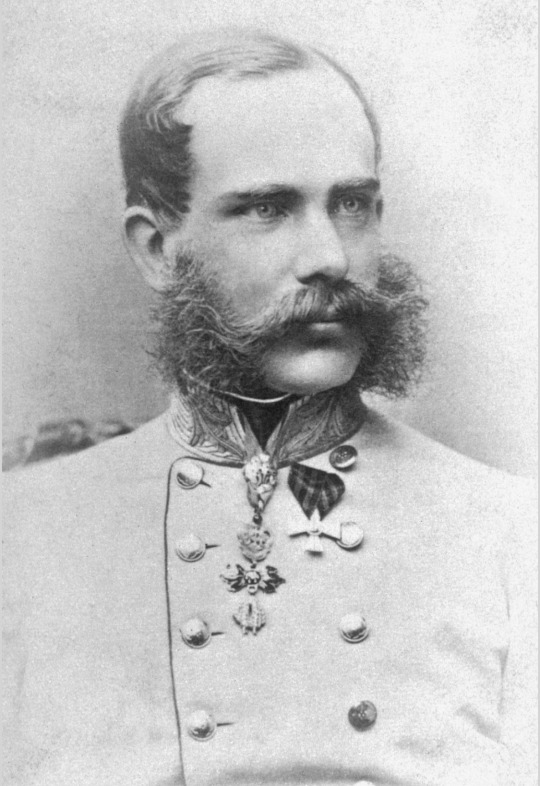
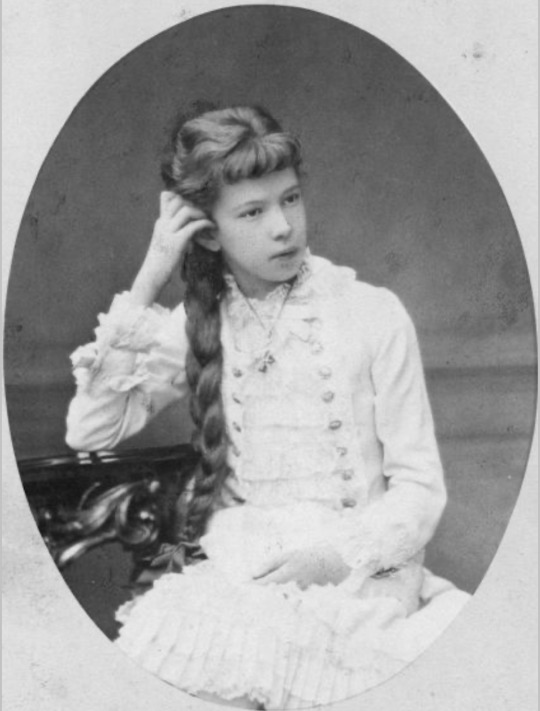
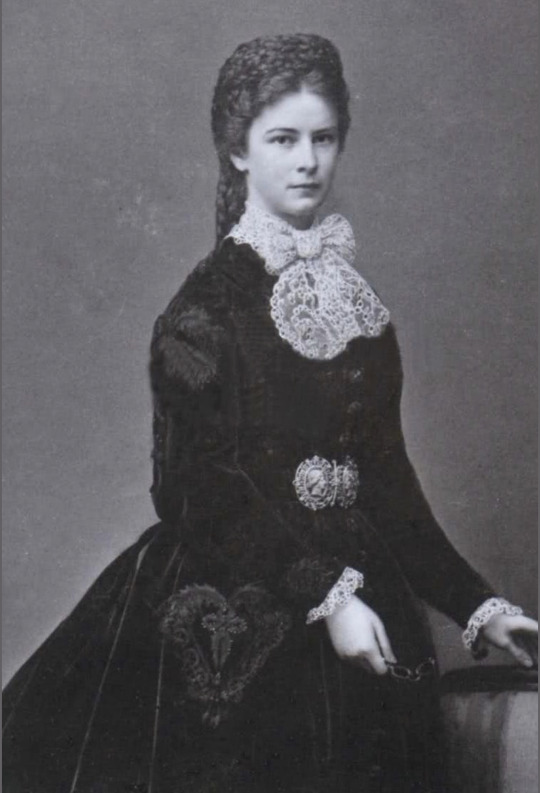
~ Rumors About Our Daughter ~ (fan fiction requested by @historical-epic)
Rumors questioning Archduchess Marie Valerie of Austria’s legitimacy have been circulating within the Austrian Court. What do her parents think about this? What do they do?
Characters: Archduchess Marie Valerie of Austria, Emperor Franz Joseph I of Austria, Empress Elisabeth of Austria
Valerie heard her mother talking to a random maid servant in the drawing room of their summer home Kaiservilla in Bad Ischl. Thought it sounded more like arguing to her.
“Don’t you dare make such treasonous accusations!” Elisabeth shouted, loud enough for 8 year old Valerie to make out what she said.
“Y-Y-Your Majesty….I didn’t mean to…I was just implying that”
“What, that my daughter is illegitimate? That her father is not The Emperor? How dare you!”
Valerie had never heard her mother this angry before. It was quite shocking, more shocking than the rumors of her own illegitimacy.
These rumors were swirling in and out of Kaiservilla for months now, mostly the fancy talk of lower servants. When the imperial family arrived, the servants had to be more careful about their gossiping and shut out their willful thoughts as these thoughts could imprison them for life, or even worse, death.
Emperor Franz Joseph I was married to Duchess Elisabeth of Bavaria, who later became Empress Elisabeth of Austria by marriage. But everyone close to her called her either Mother or Sisi.
Together they had four children. Archduchess Sophie, who died young, Gisela, Rudolf, and Marie-Valerie. They all lived somewhat happy lives although there were problems in all.
Franz and Sisi had to bear the burden of ruling an all powerful Austro-Hungarian empire, Rudolf had to bear the burden of being heir, Gisela had to bear the burden of being unloved by her parents (it was very complicated), and Valerie now had to bear the burden of various rumors spreading about who her real father was.
There are plenty of servants and nobles who live at Kaiservilla and that means that there are various mouths to blab whatever they want about whoever they want.
A few months ago, the topic of Empress Sisi and her lover Count Andrássy was being spoken about and somebody must’ve put together that Valerie might not have been her father’s daughter.
These were obviously just nonsensical rumors because Valerie was Franz’s child. She was legitimate.
But Valerie herself didn’t know that and neither did all of the servants who had been blabbing their mouths off for months.
“Get out of my sight! Sisi practically screamed at the frightened chamber maid who unfortunately gossiped at the wrong time to a footman.
The maid scurried off and Sisi sat down on the nearest chair and was trying to hold in tears.
“Mama..” Valerie walked in from the other room. “Was that maid talking about me?” She asked.
“Oh darling” Sisi held out her hands to embrace the trembling young girl who started to cry.
“Don’t pay any mind to what that filthy servant said. It was all lies and it wasn’t true at all.”
Sisi stroked her daughter’s unruly dark brown hair and continued to do so until Valerie broke the embrace.
“But Mama…I heard it all…I don’t know what this all means.” Valerie was on the verge of hysterics.
Seeing her mother so upset ignited something in her that is usually hidden away. It made her angry and confused and utterly upset.
“Valerie darling” Sisi soothed. “All you have to believe is that you are your father’s daughter, you are my daughter. If somebody said that you aren’t then shame on them!”
Sisi gave her youngest daughter a little playful slap which turned the sad frown on Valerie’s face into the wide smile that would be seen playing outside with her dogs or drawing pictures with her mother.
“You are Archduchess Marie Valerie of Austria, youngest daughter of Emperor Franz Joseph I of Austria, King of Hungary. That is who you are and you can’t listen to anybody if they say otherwise, especially the nasty servants who gossip.” Sisi softly placed a hand on Valerie’s face.
“Okay Mama, I love you very much.” The two hugged firmly again.
“Next time Valerie, don’t eavesdrop okay?” Sisi said strictly, but with a laugh.”
“Okay Mama!” Sighed smart Valerie as she skipped out of the room.
~
Later that night, when Valerie was doing her nighttime prayers, Sisi was informing Franz about the events of the day.
“Franz, darling,” Sisi spoke to her husband who was sitting calmly on the bed taking his boots off.
“Many people are questioning Valerie’s legitimacy, today I caught a maid servant gossiping with a footman. I’m greatly concerned.” Sis went over to sit next to Franz who wrapped his arm around her.
“Darling, you know those rumors are false. I remember the night we conceived. It couldn’t possibly be anyone else. What makes you so worried?” Franz said
Sisi wanted to say that the rumors were specifically stating that Count Andrássy was the suspected father and that she never did anything with him except one small kiss, but she couldn’t say that to her husband.
She loved Franz and Andrássy’s kiss brought her no affectionate feelings, minus disgust and anger, but this was just not the right time.
That was a story for another day.
Sisi decided to tell Franz the truth about half of the worries about this situation.
“I’m worried because Valerie was in the other room and she could hear me yelling at that maid.” Sisi was close to tears.
“She has never heard me that angry before and she came up to me afterword and was quite distressed...” Sisi wept into Franz’s arms while he gently stroked her back.
They might not have been passionate soulmates, but after all these years of marriage, Franz still loved Sisi, and the feeling was mutual.
“Sisi darling hush now, I will talk to her, I promise.” Franz stated his wife in the eye and gave her a gentle kiss on the forehead.
He then exited the room and let Sisi undress peacefully.
As Franz was walking to Valerie’s rooms, he couldn’t stop himself from thinking more deeply about the rumors.
Why would anyone think that Valerie is not my daughter?
Valerie heard a sudden knock on her bedroom door.
“Valerie, darling, it’s Papa, can I come in?”
“Enter.” Valerie spoke softly as her nanny calmly put the book away and exited the room.
Franz came in and slowly sat down on Valerie’s bed.
“What’s wrong Papa?” Valerie noticed the solemn look on her father’s usually joyful face. At least he was joyful when she was around.
“Valerie…” Franz spoke in a nervous but fairly calm tone. “Mother told me about what happened today.”
Valerie’s face fell into a sad frown.
“Does everyone think like that maid thinks?” She said desperately. “Mama says that I shouldn’t listen to them…but I did.”
“Oh Valerie my dearest,” Franz wrapped his daughter in a tight embrace and rocked her around like he did when she was a baby.
“Look in my eyes, Valerie, you are my daughter. Nothing can or will ever change that.” Franz was disgusted by these ugly rumors. His heart knew that Sisi could’ve and would’ve been unfaithful at times, and he could’ve been too. But he knew deep down in his heart that Valerie was his child, nothing could convince him otherwise.
“Papa is that really the truth?” Valerie asked longingly.
“Darling,” Franz cooed. “It will forever be the truth.”
“Oh Papa I love you so much!” Valerie gave her father a kiss on the cheek and a tight squeeze before hopping under her covers.
Franz kissed the little girl goodnight and exited calmly.
He knew that everything was going to be okay, and if not, he would take care of it.
~
#I hope you like this!#🤍#rumors about our daughter#fan fiction#historical-epic#history fan fiction#My fics#archduchess marie valerie#archduchess Marie Valerie of Austria#Marie Valerie of Austria#emperor franz joseph#empress elisabeth of austria#franz joseph i#Elisabeth of Austria#Austrian royal family
36 notes
·
View notes
Note
Hello😁 can you share your favorite queens?
Thank you for the great ask anon, of course! 🥰
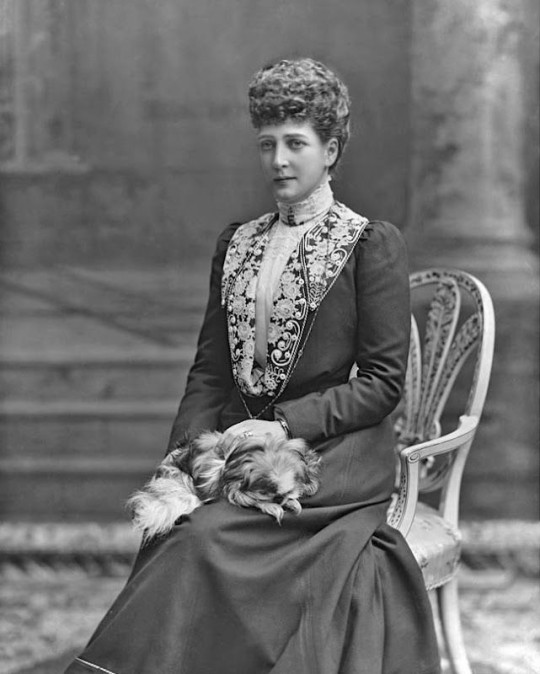
#1: Queen Alexandra of the United Kingdom – (nèe Princess Alexandra of Denmark, "Alix".
— She was beautiful, a warm and caring mother/grandmother, was popular as Princess of Wales and Queen Consort among of her people because of her good nature, and she supported many charities, including her own: "Alexandra Rose Day", founded by Queen Alexandra in 1912, this was a charity where flowers were being sold and all the money went to supporting Londoners in poverty. This was inspired by a priest in her native Denmark selling roses to raise money for those in need, Queen Alexandra brought the idea back to the United Kingdom. ❤✨
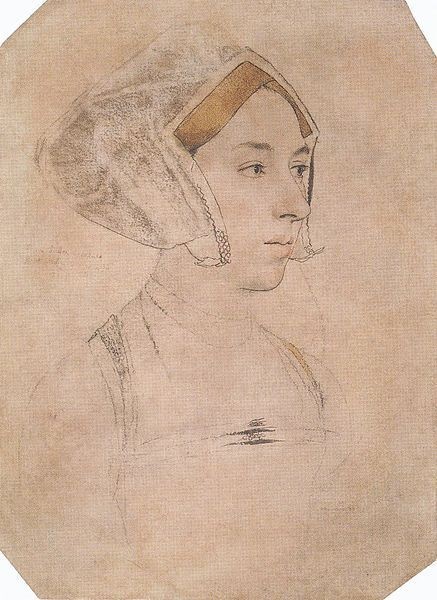
#2: Queen Anne Boleyn of England – (nèe Lady Anne Boleyn)
— She was intelligent, funny, caring and kind to all of people, and as her two years as Queen Consort she supported many charities, and even "gave alms to the poor, provided for widows, and even sewed shirts and smocks for the needy". She also helped with promoting new educational identities for monasteries, which were no longer under the protection of the Catholic Church. After only two years of being Queen Consort when she was said to have been 35 years old, she was executed after being imprisoned in the Tower of London for 17 days because she was accused of committing treason, but the true reason she was executed was because she failed to give King Henry VIII a male heir. ☹️💔

#3: Queen Marie Sophie of the Two Sicilies – (nèe Duchess Marie Sophie in Bavaria)
— She was beautiful, bright, and fierce. She was given the nickname the "Warrior Queen", the "Heroine of Gaeta" and the "modern Joan of Arc", rallying the troops, nursing the injured, feeding her forces at her own table and taunting Garibaldi's army from the battlements with the words; "Go ahead and shoot me. I will be where my men are". It was said of her that the Queen would "wipe your brow if you were wounded or hold you in her arms while you die". ❤️🔥👑
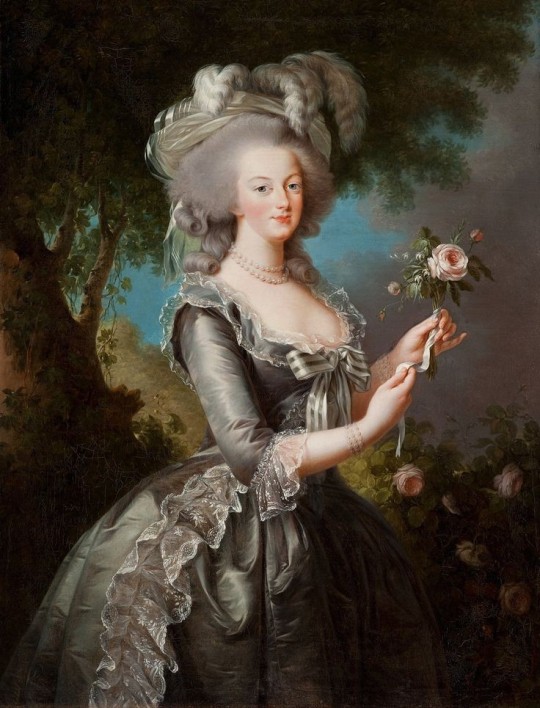
#4: Queen Marie Antoinette of France – (nèe Archduchess Marie Antoinette of Austria)
— She was honest, lovable, bold, a social butterfly who loved gambling, partying and extravagant fashions. Growing up she was closest with her sister, Maria Carolina, who was three years older, and with whom she had a lifelong close relationship. As Queen, Marie Antoinette was always unpopular, she spent lavishly, but her extravagance was only a minor cause of France's growing debt in the 1770-80s. Because of Louis XVI's indecisiveness, Marie played an increasingly prominent political role. But was very beloved for her charitable activities and patronage of the arts. She supported various charitable organizations and institutions, and she was also a benefactress of the poor. 💞🎀
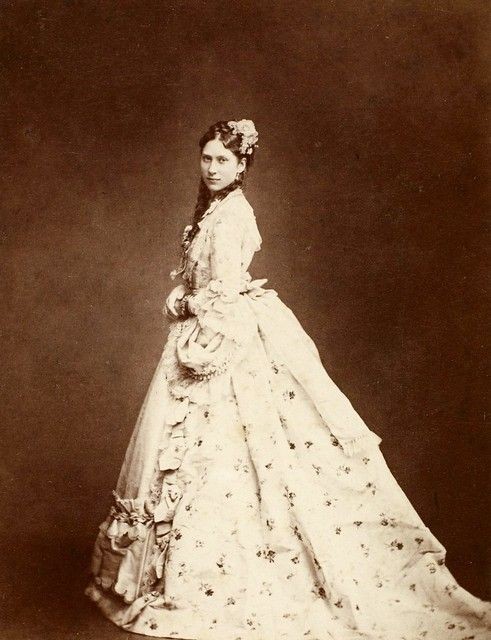
#5: Queen Lovisa of Denmark – (nèe Lovisa of Sweden)
— She was described as intelligent, with an ability to be natural, easy and friendly. And As Queen, she was mainly known for her many charity projects, an interest that she shared with her spouse. She did not care for ceremonial duties and public events, and lived a discreet life dedicated to her children and her interests in art, literature and charity. After a short tenure of only six years as Queen, she was widowed in 1912.
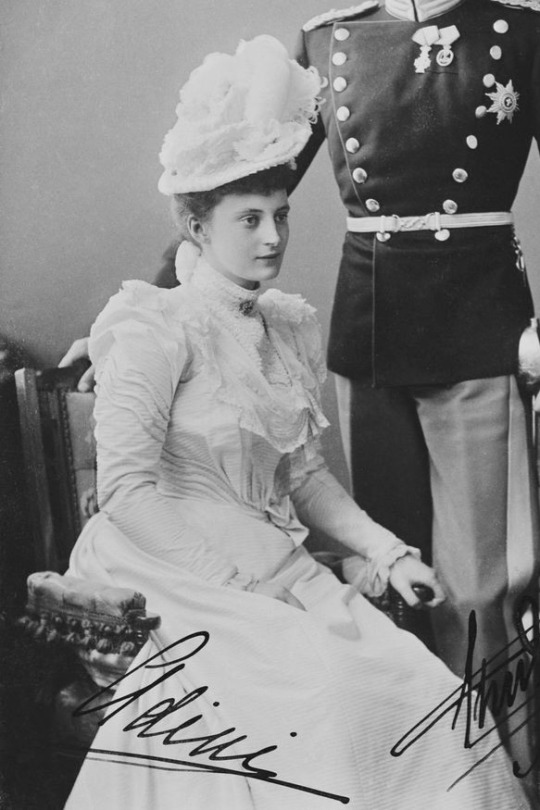
#6: Queen Alexandrine of Denmark – (nèe Alexandrine of Mecklenburg-Schwerin)
— She was reticent by nature. Her childhood was characterised by regular sporting activities, and from a young age she played the piano to a high standard. Her great interest in music stayed with her for her entire life and was passed on to her equally musical eldest son, Prince Frederik (IX). As of her first years as Queen, she had difficulty getting used to public attention, and she preferred to avoid the media limelight, but performed her functions in an exemplary manner. In the home her presence was crucial for the two boys, since Christian X was known for surrounding himself with a certain atmosphere of the barracks. Queen Alexandrine undertook extensive charity work until her death and was an avid golf player and photographer, who also loved doing needlework to a high standard. 💫
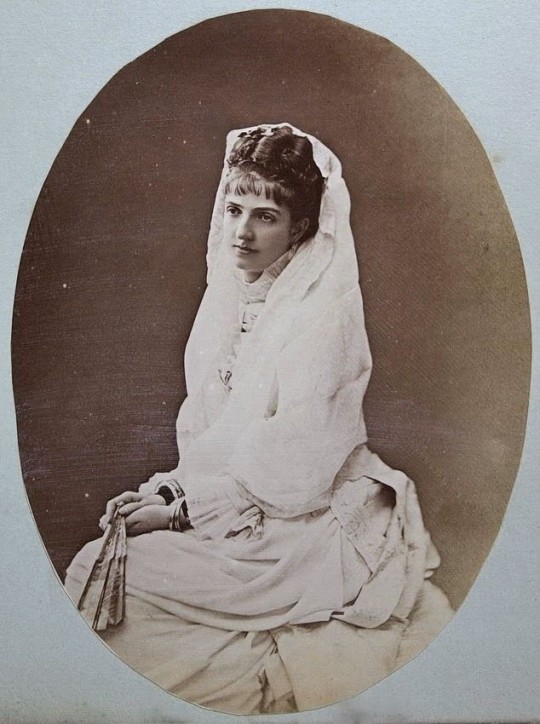
#7: Queen Margherita of Italy – (nèe Margherita of Savoy)
— She was described as sensitive, proud and with a strong force of will without being hard, as well as having the ability to be charming when she chose to. As to her appearance, she was described as a tall, stately blonde, but she was not regarded as a beauty. As Queen, she worked to protect the monarchy against republicans and socialists, and she gathered a circle of conservative intellectuals and artists known as the "Circolo della Regina" (Circle of the Queen) in her famous literary salon known as "Giovedì Della Regina" (Queen's Thursdays), where she benefited artists and writers.
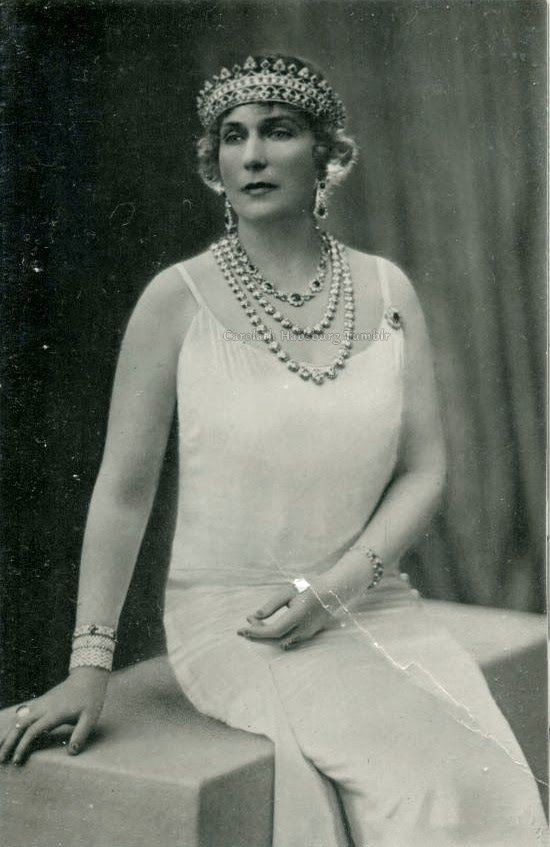
#8: Queen Victoria Eugenie of Spain – (nèe Princess Victoria Eugenie of Battenberg), "Ena".
— She was described as very kind but very strict and she devoted herself to work for hospitals and services for the poor, as well as to education. She also involved herself in the reorganization of the Spanish Red Cross. In 1929, the city of Barcelona erected a statue of her in a nurse's uniform in honour of her Red Cross work and since the the statue has been destroyed.
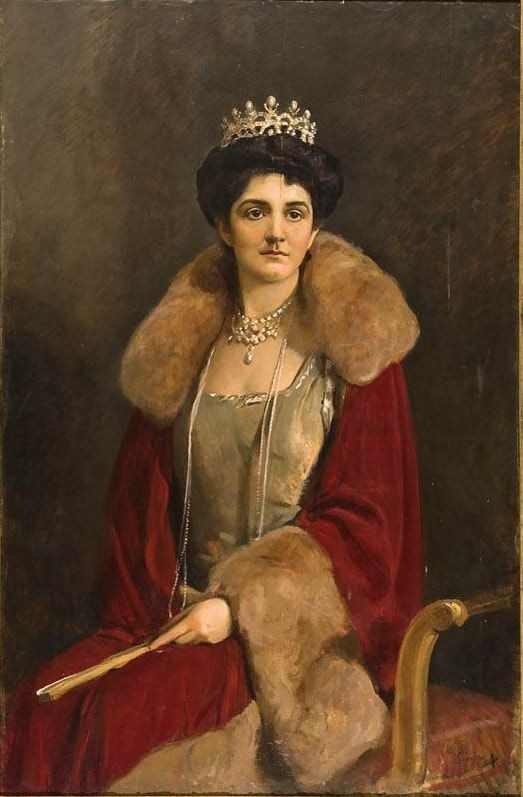
#9: Queen Elena of Italy – (nèe Elena of Montenegro)
— She was described as shy and reserved but also rather stubborn. Very attached to traditions, with a sensitive soul and a lively and curious mind, she was endowed with a strong love for nature: her favourite flower was the Cyclamen. She was a very tall woman of 180 cm (5'11). As Queen, her commitment to numerous charitable and welfare initiatives, which assured her great sympathy and popularity, was profuse. The Queen went well beyond mere charity: her evangelical spirit led her to practice every day the most genuine and most charitable love of neighbor.
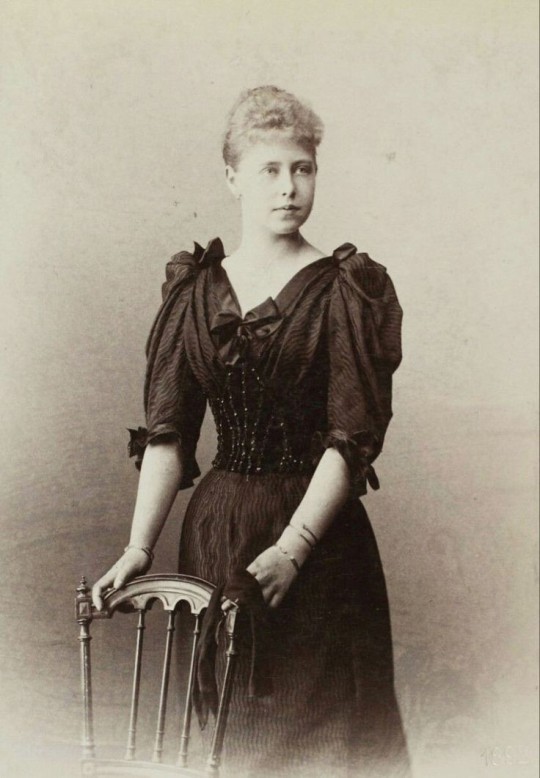
#10: Queen Marie of Romania – (nèe Princess Marie of Edinburgh), "Missy".
— She was described as very beautiful and high spirited. As a young girl, Marie was very close with her sisters, but mostly her sister Victoria Melita, they played many games with their father and Marie's mother, the Duchess of Edinburgh neglected Marie and her sisters' education, considering them not very bright or gifted. But in the fields of painting and drawing, Marie and her sisters had inherited her grandmother, Queen Victoria's talent. On October 11th, 1914, Marie and her husband Ferdinand were acclaimed as king and Queen in the Chamber of Deputies. Princess Anne Marie Callimachi, a close friend of Marie, wrote that "as Crown Princess, she had been popular; as Queen, she was more loved". Marie maintained a certain influence on her husband and the entire court, leading historian A. L. Easterman to write that "it was not Ferdinand, but Marie who ruled in Romania".
#answered ask#queen alexandra#alexandra of denmark#anne boleyn#queen marie sophie of the two sicilies#duchess marie sophie in bavaria#marie antoinette#queen lovisa of denmark#lovisa of sweden#queen alexandrine of denmark#alexandrine of mecklenburg-schwerin#queen margherita of italy#margherita of savoy#queen victoria eugenie of spain#princess victoria eugenie of battenberg#queen elena of italy#elena of montenegro#queen marie of romania#princess marie of edinburgh#informational
18 notes
·
View notes
Text


Time for the return of the “Living People Related to Maria Theresa” game!
Here we have a descendant of hers from the line of Marie Louise of Austria; through her second marriage to Adam Albert von Neipperg . Princess Marie Caroline of Liechtenstein is the only daughter of Prince Alois, heir apparent to the throne of Liechtenstein, and his wife Sophie. Marie Caroline has a Bachelor of Fine Arts degree in fashion design, and works in the fashion industry in London.
Marie Caroline of Liechtenstein (Born October 17th, 1996) –> Sophie, Duchess in Bavaria –> Max Emanuel in Bayern -> Countess Maria Draskovich von Trakostjan -> Juliana Rosa of Montenuovo –> Alfred, 2nd Prince of Montenuovo -> William Albert, 1st Prince of Montenuovo -> Marie Louise of Austria -> Francis II ->Leopold II -> Maria Theresa
#maria theresa#marie louise of austria#Marie Caroline of Liechtenstein#house of habsburg#house of#Liechtenstein#long live the queue
8 notes
·
View notes
Text
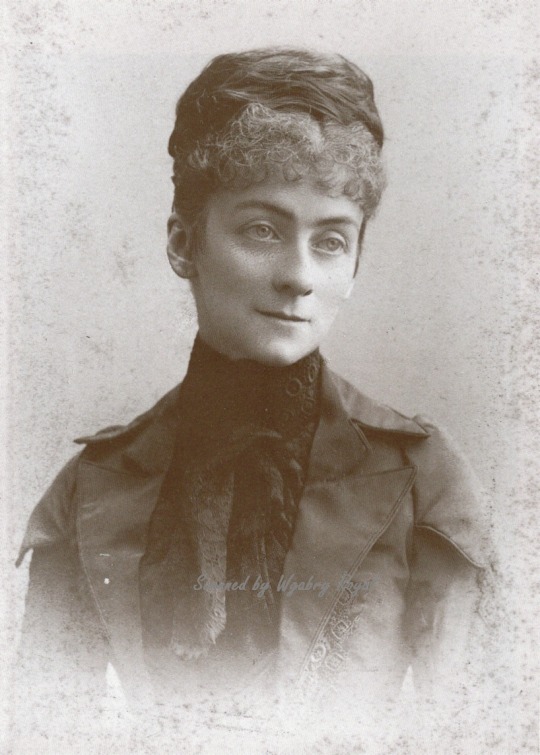
Duchess Sophie Charlotte Augustine in Bavaria wife of Ferdinand Philippe Marie d'Orléans, duc d'Alençon
Source "Das Familienalbum von Kaiser Franz Joseph und Elisabeth"
17 notes
·
View notes
Text
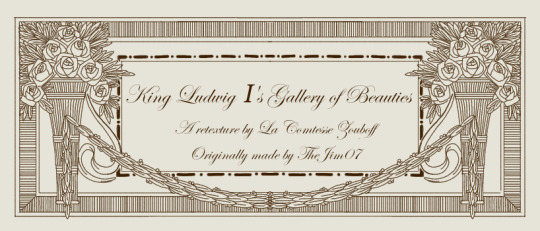
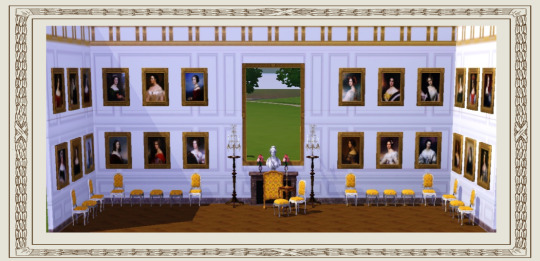
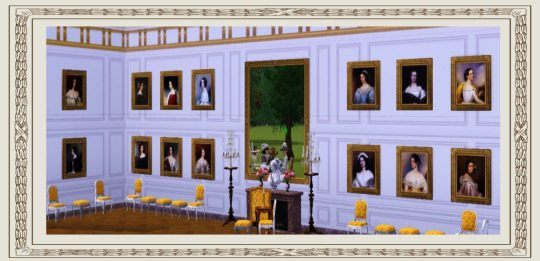
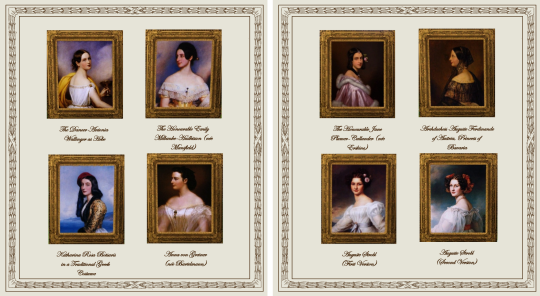


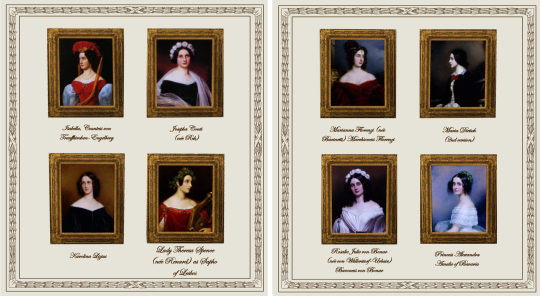
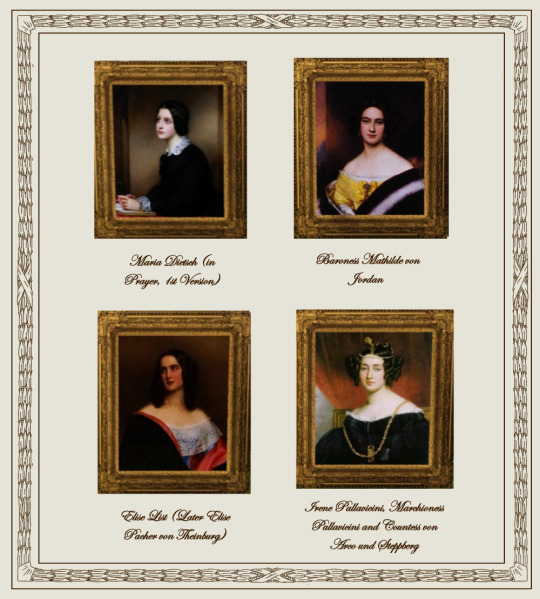

King Ludwig Ist's Gallery of Beauties.
A retexture by La Comtesse Zouboff — Original Mesh by @thejim07
The Gallery of Beauties (Schönheitengalerie) is a collection of 38 small portraits of the most beautiful women from the nobility and middle classes of Munich, Germany painted between 1827 and 1850 (mostly by Karl Joseph Stieler, appointed court painter in 1820) and gathered by Ludwig I of Bavaria in the south pavilion of Nymphenburg Palace in Munich. Two additional ones were created by Friedrick Drück and one portrait was stolen in the XXth century and remains missing.
The set includes all the 38 portraits, with the original frame swatches, fully recolorable. The portraits are of:
Friederike von Gumppenberg (later Baroness von Gumppenberg).
Amalia von Schintling.
Amalie Maximilianovna von Krüdener (née von Lerchenfeld) Baroness von Krüdener.
Anna Hillmayer.
Anna von Greiner (née Bartelmann)
Antonietta Cornelia Vetterlein.
Archduchess Auguste Ferdinande of Austria, Princess of Bavaria.
Auguste Strobl (first version).
Auguste Strobl (second version).
Baroness Mathilde von Jordan.
Carlotta von Boos zu Waldeck (née von Breidbach-Bürresheim) Baroness von Breidbach-Bürresheim.
Caroline Maximiliana Maria von Holnstein (née von Spiering) Countess von Holnstein aus Bayern
Elise List (later Elise Pacher von Theinburg
Eliza Rosanna James (née Gilbert), Known ss Lola Montez.
Helene Kreszenz Sedlmayr.
Irene Pallavicini, Marchioness Pallavicini and Countess von Arco un Steppberg.
Isabella, Countess von Traufkirchen-Engelberg.
Jane Elizabeth Digby, Later Baroness von Venningen.
Josepha Conti (née Reh).
Karolina Lizius.
Katharina Rosa Botsaris in a Traditional Greek Costume.
Lady Theresa Spence (née Renard) as Sapho of Lesbos.
Maria Dietsch (In prayer, first version).
Maria Dietsch (second version).
Marianna Florenzi (née Bacinetti) Marchioness Florenzi.
Marie Friederike Franziska Hedwig of Prussia, Crown Princess of Bavaria.
Maximiliane Borzaga.
Nanette von Kaulla.
Princess Alexandra Amalie of Bavaria.
Caroline von Oettingen-Wallerstein (later Countess von Waldbott-Bassenheim.
Regina Daxenberger.
Rosalie Julie von Bonar (née von Wüllerstorf-Urbair) Baroness von Bonar.
Sophie Friederike Dorothea Wilhemine, Archduchess of Austria (née Princess of Bavaria).
The Actress Charlotte von Hagn-Schwab as Thekla in Schiller's "Wallenstein".
The Actress Friederica Katharina "Willhemine" Sulzer.
The Dancer Antonia Wallinger as Hebe.
The Honourable Emily Mikbanke-Huskisson (née Mansfield)
The Honourable Jane Plumer-Callander (née Erskine)
Found under decor > paintings for 540§
Retextured from the "Portrait of Balsasarre Castiglione" found here
-------------------------------------------------------
CC shown here:
Wall paneling, mirror, girandole and floor by @thejim07
Fireplace by @hydrangeachainsaw
Chairs, stools, flower vases, bust, table, fireplace screen and candelabra by @joojconverts
Torchere by @martassimsbookcc
(Btw excuse my sims' reflection having tea)

Drive
(Sims3Pack | Package)
(Useful tags below)
@joojconverts @ts3history @ts3historicalccfinds @deniisu-sims @katsujiiccfinds
-------------------------------------------------------
#the sims 3#ts3#sims 3 cc#portrait#s3cc#sims 3#sims 3 download#sims 3 decor#joseph karl stieler#Munich#germany#nymphenburg#wall decor
92 notes
·
View notes